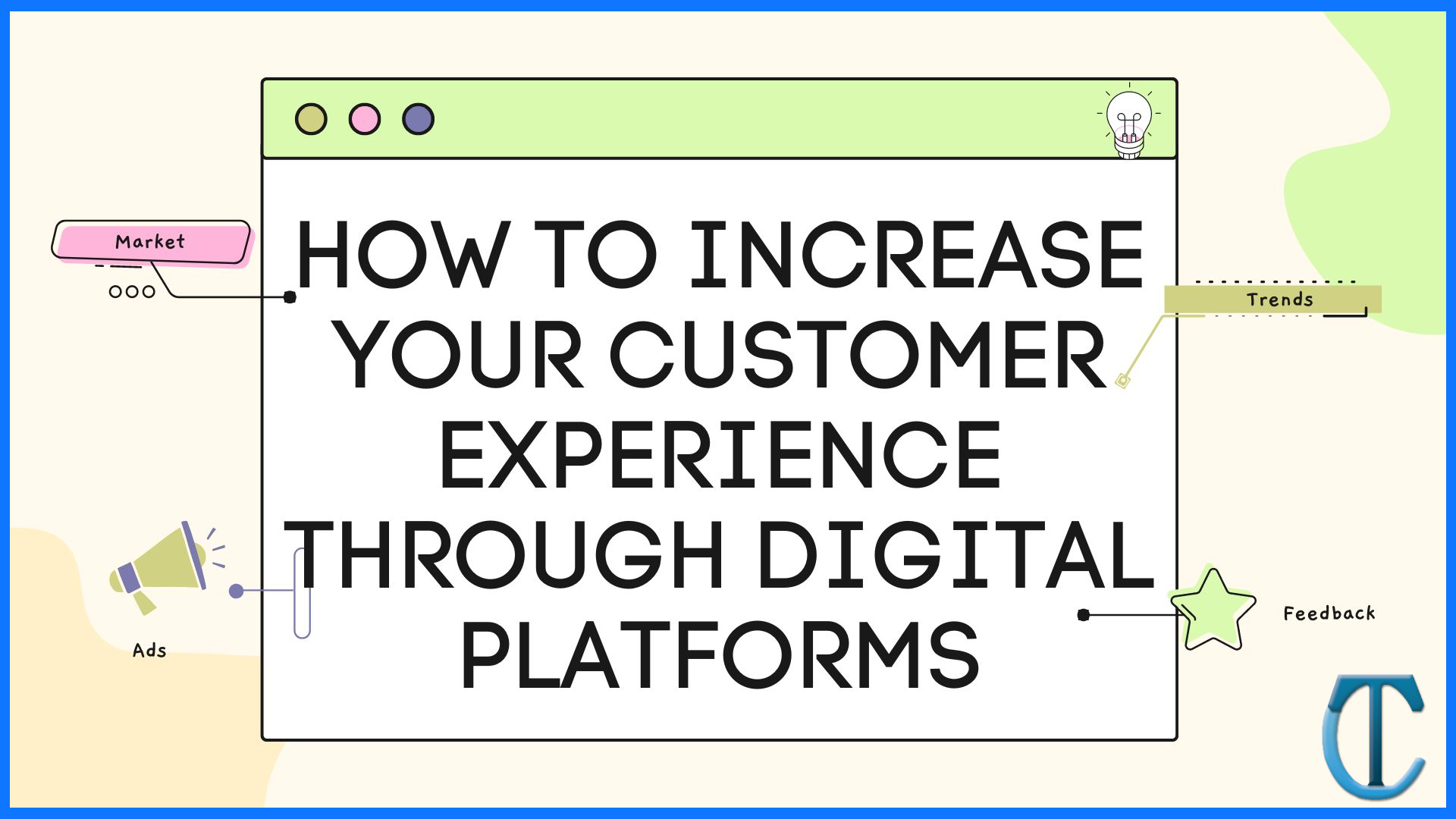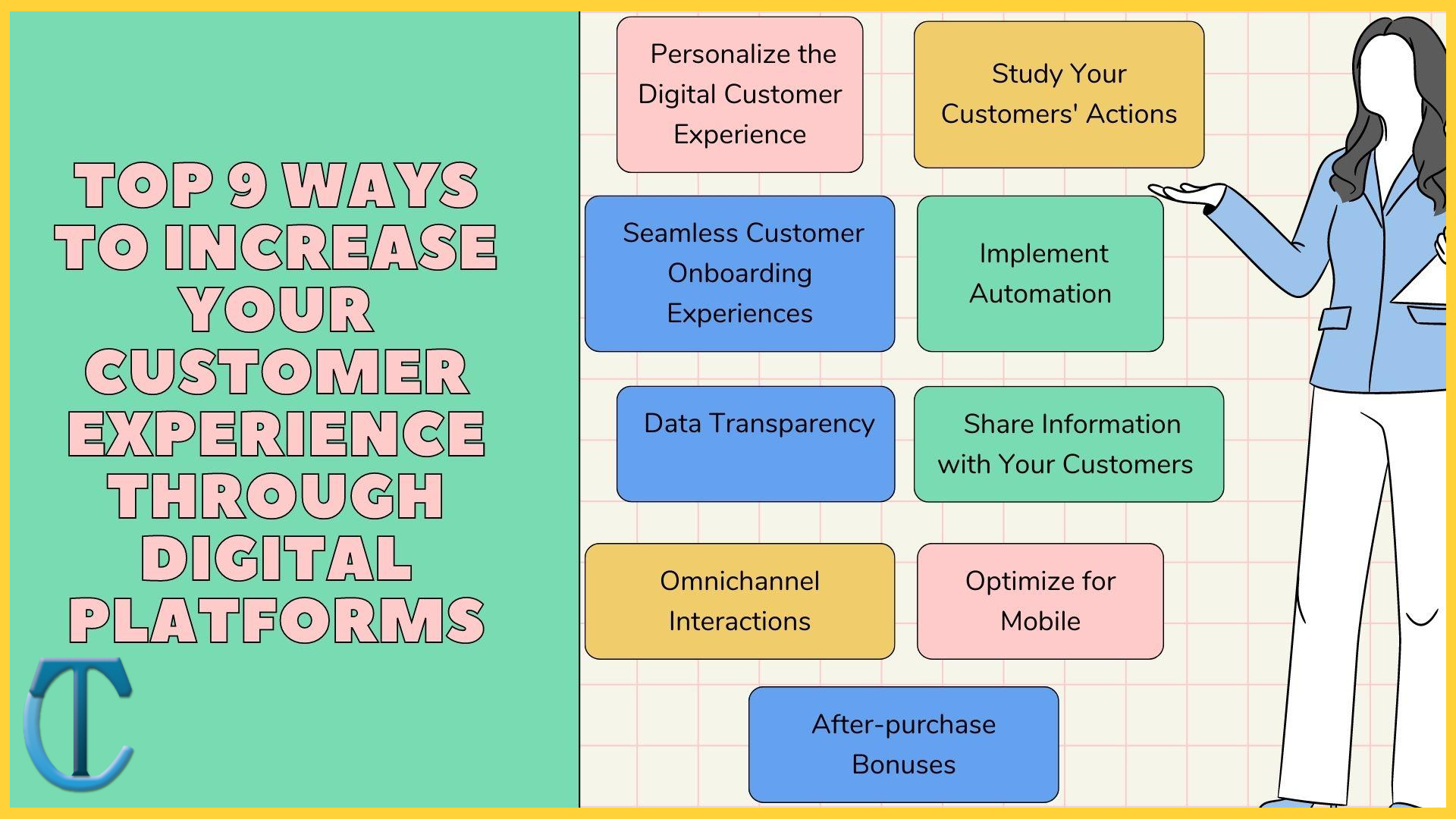
How to Increase Your Customer Experience Through Digital platforms?
Introduction
It’s no longer news that the digital landscape is rapidly changing. You have
seen various dramatic shifts in communication, as well as how you buy products
and services. Brands must embrace digital transformation, which includes using
digital platforms to keep up with the ever-changing digital world. Already,
90% of companies
have some kind of digital initiative.
One way of optimizing your digitalization is by employing content marketing
services. Both
big and small firms
need good content strategy and only a professional content marketing agency
can provide such. Content marketing for start-ups and small businesses are
especially important since they need the most exposure.
In this article, we will explore how companies can prepare for these changes
by using various digital platforms to improve customer experience. Let’s get
started!
But First, What are Digital Platforms?
In simple terms, digital platforms are software-based online infrastructure
that facilitates transactions and interactions between users. Generally, these
platforms act as data aggregators, helping users navigate a massive amount of
information.
These platforms are mainly used by a content marketing agency. However, as a
startup, you can include it in your startup marketing strategies. It is
noteworthy that digital platforms can be more or less decentralized in their
data architecture. Furthermore, they can be governed based on more or less
distributed decision-making.
The use of digital platforms is an example of digital transformation. Hence,
the concept of digital platforms is incomplete if we don’t examine what
digital transformation is.
So, What is Digital Transformation?
Digital transformation is necessary for online visibility. It involves
overhauling your business processes and systems to meet the demands of a
digitally connected world. These demands include changes in how you operate
internally and externally. The digital transformation process also requires
unending online business ideas. So you must deliver continually.
The four key components involved in digital transformation are:
- Product and service innovation
- Culture change
- Technology integration
- Customer experience
For your business to successfully undergo digital transformation, you must
identify what’s vital to your customers and how you can best meet their
needs.
Another major way of achieving digital transformation is by content
optimization.
Content optimization
improves user experience as it makes your webpage appealing and
seamless. It ensures that your content reaches the largest
possible and prospective audience. For content optimization, your content
strategy must be solid. As earlier stated it’s best to outsource this to a
professional content marketing agency.
The possibilities that digital transformation opens up are endless. It is all
about exploring how your business can increase customer experience. Some of
the most common examples of companies that have successfully undergone digital
transformation include Apple, Amazon, Uber, Airbnb, etc.
It is important to note that these companies started as brick-and-mortar
businesses. However, they transformed into digital companies with access to a
digital platform.
This said, let’s discuss how you can increase your customer experience through
digital platforms.
Top 9 Ways to Increase Your Customer Experience Through Digital platforms
Below are a few digital tips that are helping brands enhance their customer
experience.
1. Personalize the Digital Customer Experience
A perfect way to personalize the digital customer experience is through
content optimization, which changes based on individual preferences or past
behaviors.
Regardless of the platform, every customer expects a personalized
experience. They want to feel as though you are speaking directly to them,
not just another faceless customer in a long line.
2. Study Your Customers’ Actions
To understand how your digital experience should look, you must first
recognize who your customers are and what they do. The best way to accomplish
this is to build a customer journey map for each of your buyer personas.
It is much easier to understand your customers’ demands of the digital
experience if you first understand their various behaviors. Creating customer
journey maps can assist you in managing and outlining the digital experience.
3. Implement Automation
Automation is yet another way to improve customer experience through digital
platforms. With automated processes, you can reduce wait times and provide
instant responses, which are essential for customers with little patience and
high expectations.
An example of an automated process that improves customer experience is
chatbots. Chatbots are computer programs that imitate human conversation, and
they’re becoming increasingly popular for
customer service
interactions. So clearly, customers prefer automation as part of a customer
satisfaction strategy.
4. Seamless Customer Onboarding Experiences
New customers are crucial for your
business growth, as they bring knowledge, money, and connections that benefit your brand for
years. However, there’s a catch. Most companies have terrible “onboarding
experiences” when new customers first sign up or join their community.
More often than not, this leads to high customer churn rates due to a
complicated onboarding process. With digital platforms, you can improve
onboarding experiences through simplified processes and more helpful guidance.
5. Data Transparency
Over the years, how companies
collect and use data
has been a controversial topic. While some organizations take critical steps
to protect customer information, others do not put enough effort into
it.
This leads to different things, including identity theft or worse! However,
digital platforms make it easier for users to see what kind of data is being
collected and how it’s being used.
This transparency improves customer experience since customers can see with
whom they share their information. This does a good job in building customer
trust and long-term relationships. Simultaneously, businesses have to take the
necessary steps to gain consumer trust, which will help them grow their
business more quickly.
6. Share Information with Your Customers
Constantly keeping customers in the loop is another effective way to improve
and increase their experience with your brand. When customers are carried
along, they’re less likely to feel frustrated or anxious.
Digital platforms can help you share information with customers in various
ways. For instance, you can send out post updates on social media, regular
email newsletters, or create an interactive customer portal where they can
access information on their schedule.
However, ensure the information is easily accessible and easy to understand. A
great example of a company that does this well is Amazon. Customers easily get
informed about the latest products, services, and deals.
7. Omnichannel Interactions
Customers want to get in touch with you on their own terms. Your customers
will have a unified purchasing and support experience from your company if you
use omnichannel.
To contact a specific company, a customer can use three to five different
communication channels. As a result, it is in your best interests to connect
and interact with their clients at various touchpoints.
8. Optimize for Mobile
Nowadays, users live through their smartphones. The majority of online
purchases are made via phones. With that in mind, it makes sense to ensure
that your website, app, or other online materials are mobile-friendly. As a
result, the user experience meets their expectations.
When it comes to mobile optimization, the two most important factors to
consider are website load time and ease of navigation. Customers will leave if
a page takes too long to load. Mobile users will prefer to do business with
companies that have mobile sites or apps that facilitate better purchases.
9. After-purchase Bonuses
Follow up on every sale to grow your list of satisfied and loyal customers.
You could send videos demonstrating how to use the purchased item.
Alternatively, you could provide a free gift in exchange for completing a
survey about their experience. Make your digital customer experience seamless
and never-ending.
Best Digital Platforms for You to Improve Customer Experience
Your customers’ experience is paramount in any business. Happy customers make
more purchases. Improving user experience takes more than a simple wish. You
have to put in the effort and employ the right tools.
Here are some digital platforms that you need to improve the customer
experience:
1. Customer Experience Management Platforms
Customer experience management platforms encompass a wide range of
functionality under a single umbrella, with the overarching goal of assessing
the overall quality of customer experiences.
Platforms use scoring mechanisms to better comprehend particular moments and
interactions in the customer experience, highlighting experiences that need to
be improved.
2. Platforms for Frontend Experience
Frontend experience platforms, by acting as a centralized content hub, aid in
the creation and delivery of tailored experiences across e-commerce channels.
On top of online shop systems, the platform adds a flexible and efficient
frontend layer as well as a commerce CMS.
As a result, the e-retailer can provide a more seamless, interactive
e-commerce experience with faster page loads and shorter time-to-market. This
means that shop webpages will be more agile and controllable. Thus allowing
marketers and designers to deploy immediate site changes.
3. Helpdesk Platform
It acts as a key repository for any and all helpdesk interactions in a single,
searchable database. Modern helpdesk solutions, when integrated with CRM
platforms, enable real-time tracking of user satisfaction on an interpersonal
basis. These platforms assign tickets to each dialogue and use analytics and
dashboards to track resolution. Integration with call center software, as well
as automated survey functionality at the end of each interaction, is common.
4. Personalization Platforms
These are powered by marketing-specific AI and machine learning. They turn
rich customer data sets into personalized engagement. Also, they use
predictive modeling and AI to create product recommendations based on previous
customer feedback or real-time behavior. This engages customers on their
preferred channels and at their preferred times.
5. Post-Purchase Platforms
The e-commerce journey does not end when a sale is made. To begin with, it’s
easier for customers to
receive an e-receipt
following an online transaction. Also, most of them are willing to receive
extra content and offers in their receipt messages. Post-purchase platforms
keep the conversation going by providing details like delivery tracking or
shipment updates via email, push, and text messages.
6. Customer Feedback Management Tools
Tools for managing customer feedback make a centralized and automated
environment for gathering customer feedback available. They allow for the
creation, scheduling, and execution of customer surveys, polls, and
questionnaires. They also aid in the compilation of survey results
reports.
The tool automatically generates quantifiable data from customer comments,
reviews, emails, or chats. This allows for the identification of
dissatisfaction and churn risk. When advanced solutions detect negative
feedback, they automatically generate helpdesk tickets.
7. Customer Relationship Management (CRM) Platforms
CRM platforms integrate customer data capture with a wide variety of
advertising automation and analysis tools. Contact management, interaction
tracking, and scheduling/reminders are all standard features. AI-powered sales
assistance and help desk integration are advanced tools, with a trend toward
covering a broad array of functions within a single CRM system.
8. Social Media Platforms
Social media tools utilize customer profile data to provide customized
interaction across social media channels. Social media software allows brands
to create, manage, and share content across multiple channels in a single
application. It promotes collaborative workflows while optimizing content
impact through adapted re-use across channels. Also, it supports social media
listening, measuring, and managing customer data based on social behavior.
9. Customer Engagement Platforms
Let’s take a step further than conversion and sales. Customer engagement
platforms manage interactions throughout the customer lifecycle. They give
marketers from various teams a unified solution to manage all customer
touchpoints.
Calendars, CRM, social media, and email marketing are all examples of this.
Again, the emphasis is holistic and includes activities such as selling,
retention, reactivation, and expansion.
Bottom Line
Of course, the use of digital platforms and transformation is a way forward
for most companies. Particularly when companies are increasingly focusing on
providing a great customer experience.
With both, businesses can improve the overall customer experience by making it
more convenient and personalized. However, it is inadvisable to leverage
digital platforms just for the sake of it. First and most importantly, define
your goals and be sure of the processes you want.
Also, think and restructure such that while these platforms can help in
engaging customers and increase online visibility, it also helps you realize
your business goals and improve content analysis.
Frequently Asked Questions on Ways to Increase Your Customer Experience
Through Digital platforms
1. Why must I transform my business digitally?
Digital transformation ensures business growth and helps you stay ahead of
your competitors. Furthermore, it increases the flexibility of your end-to-end
business processes.
Most importantly, it is important to transform digitally if you’re looking
to increase and improve your customer experience.
2. What should be a priority when considering the use of digital platforms?
Your priority should be ensuring you have data of high quality that you can
constantly iterate and improve.
3. What are the key components of a digital platform?
The top three key components include broad integrative functionality, customer
experience, and technology innovation.
4. Do B2B and B2C organizations use the same digital customer experience?
B2C users are part of an organized market and frequently rely on conformity
forces. On the other hand, a single customer may represent the entire target
sector of a B2B. B2B digital customer experience can be undervalued. But
businesses want the same smooth, reliable, and seamless service as a B2C
consumer, so set similarly strict standards.




